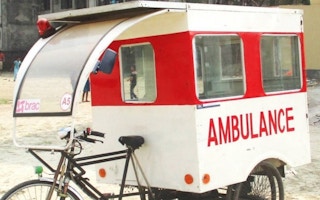An inexpensive, solar-powered ambulance that can fit down narrow laneways is set to hit the road in rural Bangladesh this year, its manufacturers say.
The three-wheeled van, as well-equipped as ambulances used in Bangladesh’s cities, runs entirely on solar power – including solar battery power at night – and can be used in rural areas with no grid electricity, according to the developers.
A Bangladeshi university, a government organisation and a local vehicle manufacturer who are collaborating on the vehicle say it should for the first time bring ambulance service to rural areas without it.
The vehicle is in the field testing stage and there are plans to launch it by the end of 2017.
“
I thought a low-cost ambulance service would be a good idea for these rural clinics. And by using solar power we can reduce operational costs and save the environment.
A.K.M. Abdul Malek Azad, team leader and professor, BRAC University
In many rural areas, emergency patients are often taken to hospital in hand-pulled rickshaw vans. But the new, small three-wheeler ambulance will fit along narrow roads in rural areas where it is difficult for larger ambulances to run.
Zahidul Islam, a farmer in Saturia in Manikgonj district, said that when his first child was born his wife had a difficult delivery and was taken to the nearby clinic in a hand-pulled rickshaw – a trip that took too much time.
“If I had taken her to hospital a little earlier, she would have had fewer complications,” he said. But larger vehicles could not reach his house, he said.
He believes that faster, smaller ambulances would be helpful for rural people.
Safe and comfortable
Kamal Hossain, a driver who has tested a prototype of the ambulance, said that it was safe and comfortable to drive on both smooth and rough surfaces, and went at a good speed.
A.K.M. Abdul Malek Azad, the project’s team leader and a professor at BRAC University in Dhaka, said that most rural community health clinics cannot afford conventional ambulance services, but that the new ambulance would be cheap to buy and to run.
“I thought a low-cost ambulance service would be a good idea for these rural clinics. And by using solar power we can reduce operational costs and save the environment,” he said.
The ambulance is expected to cost $1,900 to $2,500, a fraction of the price of conventional ambulances, which can cost at least $30,000 in Bangladesh.
BRAC University’s Control and Applications Research Centre is running the project in association with vehicle manufacturer Beevatech. Financing comes from the World Bank through Bangladesh’s Infrastructure Development Company Limited, with seed funding from the U.S. Institute of Electrical and Electronics Engineers.
Race car inspiration
Azad said that, as far as he is aware, there is no equivalent elsewhere in the world of the solar-powered three-wheeler ambulance his team is developing. The inspiration for it came from solar racing cars in Australia.
“I thought if researchers can develop a solar racing car, there is potential to develop a solar ambulance,” he said. A vehicle that would not be reliant for power on Bangladesh’s overburned national power grid would be a bonus, he explained.
The new ambulance can accommodate three people. It has a maximum speed of 15-20 km per hour (9-12 mph), and a range of up to 50 km (30 miles).
By day it is powered by four 100-watt solar panels on the roof. At night it runs on four 12-volt batteries, which are charged from the solar panels.
“The last layer of the development includes installation of a battery charging station (at a hospital or other site close by) that is completely fuelled by a solar canopy,” Azad said. “This step is taken to ensure complete independence of these electrically assisted rickshaws from the national grid.”
The ambulance’s battery can recharge in three to four hours, he said.
Azad said his team has built and tested five prototypes over the past year. The new ambulances are expected to hit the roads at the end of 2017.
He expects that buyers will include community clinics across the country run by the BRAC non-governmental organisation. Azad says officials of the BRAC Health and Nutrition Programme have assured the team they will consider using the vehicles in their clinics.
Dr. Shahana Nazneen of the BRAC Health and Nutrition Population Programme said that the vehicles are cost-effective and should be affordable for rural hospitals.
Habibur Rahman Khan, an additional secretary at the Health Ministry in charge of hospitals, agreed that the low-cost ambulance would help the ministry boost health facilities in rural areas.
“We will certainly consider purchasing (them) for rural hospitals,” he said.
This story was published with permission from Thomson Reuters Foundation, the charitable arm of Thomson Reuters, that covers humanitarian news, climate change, resilience, women’s rights, trafficking and property rights. Visit http://news.trust.org/climate.
The Thomson Reuters Foundation is reporting on resilience as part of its work on zilient.org, an online platform building a global network of people interested in resilience, in partnership with the Rockefeller Foundation.










